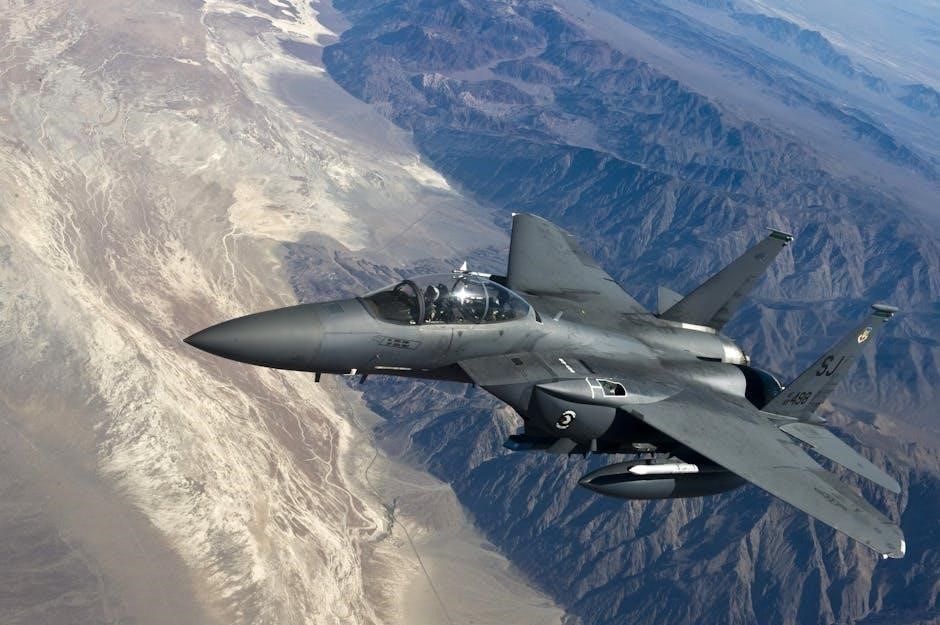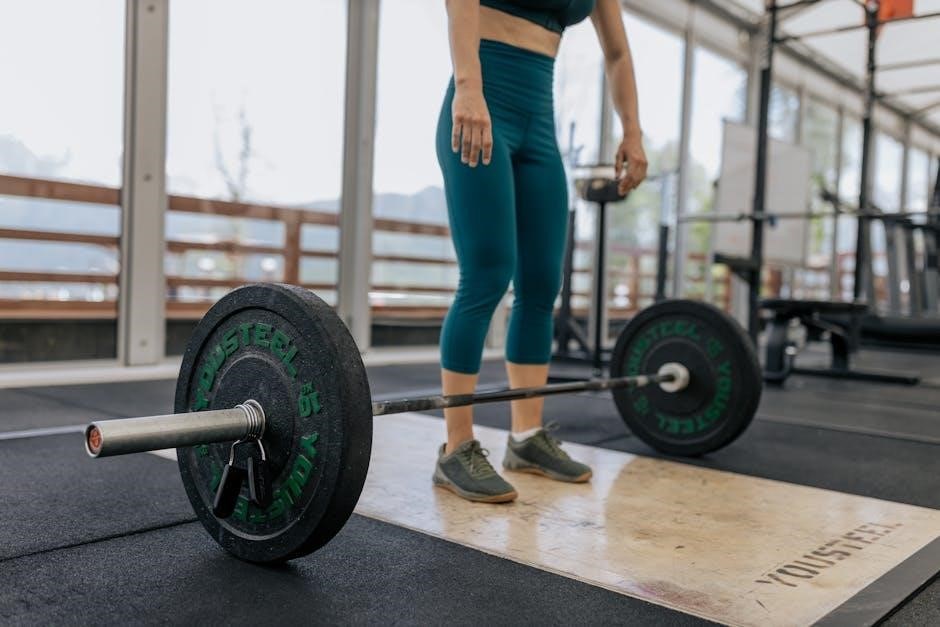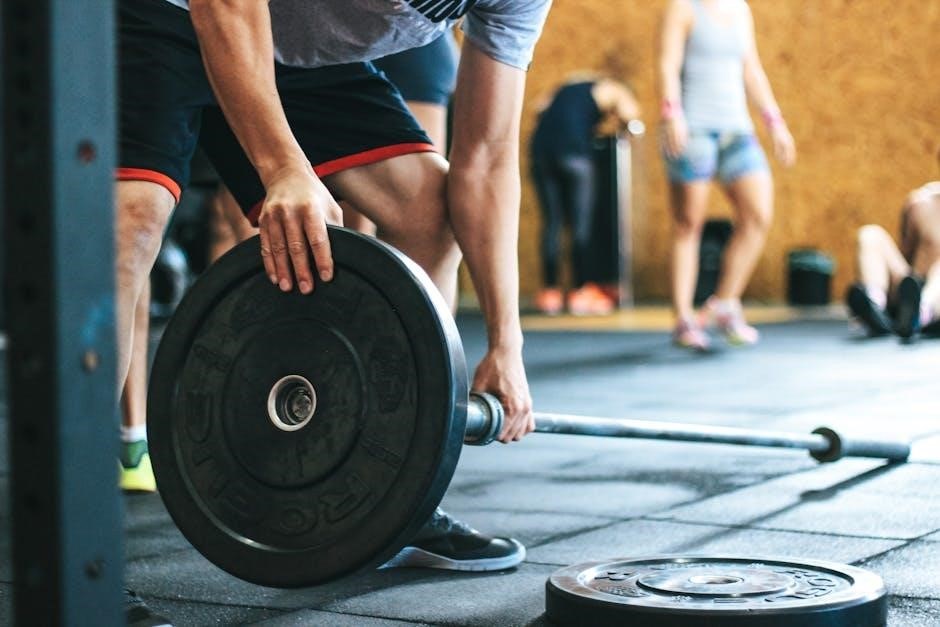
Tactical Barbell is a comprehensive strength and conditioning system designed for operational athletes, focusing on multi-dimensional fitness and real-world applicability.
It provides structured programs for military, law enforcement, and tactical professionals, emphasizing strength, durability, and peak performance in high-stress environments.
What is Tactical Barbell?
Tactical Barbell is a structured strength and conditioning system tailored for operational athletes, such as military personnel, law enforcement, and first responders. It combines strength training with conditioning to enhance multi-dimensional fitness, ensuring optimal performance in high-stress environments. The program emphasizes functional strength, endurance, and mental resilience, avoiding unnecessary bulk. Tactical Barbell offers customizable templates, including Operator, Zulu, and Mass programs, to suit different goals and operational demands. By focusing on barbell exercises, it builds strength and durability without compromising athletic ability, making it a practical choice for those requiring peak physical readiness in real-world scenarios.
Purpose and Scope of Tactical Barbell
Tactical Barbell is designed to enhance the physical and mental capabilities of operational athletes, ensuring they can perform optimally in high-stress, real-world scenarios. Its primary purpose is to build functional strength, endurance, and durability while avoiding unnecessary muscle bulk. The program’s scope includes structured templates like Operator, Zulu, and Mass, catering to diverse operational needs. By focusing on barbell exercises, it provides a practical, efficient way to improve overall fitness without compromising athletic ability. Tactical Barbell’s goal is to prepare individuals for the demands of their duties, ensuring peak readiness and resilience in challenging environments.
Who is Tactical Barbell Designed For?
Tactical Barbell is specifically tailored for operational athletes, including military personnel, law enforcement officers, and first responders. It is also suitable for recreational athletes seeking a functional strength program. The system focuses on individuals who require peak physical performance in high-stress environments. By avoiding unnecessary bulk, it ensures agility and endurance, making it ideal for those needing multi-dimensional fitness. Tactical Barbell’s structured templates, such as Operator and Zulu, cater to diverse needs, providing a practical and efficient approach to strength training. This program is designed for anyone needing real-world strength and durability without compromising their operational readiness.
History and Development of Tactical Barbell
Tactical Barbell was developed by K. Black for military and law enforcement, focusing on strength and conditioning. It evolved to serve broader tactical communities.
Background and Origins of Tactical Barbell
Tactical Barbell was created by K. Black to address the unique needs of military and law enforcement personnel. Initially, the tactical community viewed barbell training with skepticism, associating it with bodybuilding rather than functional strength. Black developed the system to bridge this gap, focusing on multi-dimensional fitness for operational athletes. The program integrates strength and conditioning, emphasizing real-world applicability. Tactical Barbell’s origins lie in its practical approach, offering structured templates and progression schedules. Resources like PDF guides and interactive spreadsheets have made the system accessible, helping athletes achieve peak performance without sacrificing mobility or endurance.
Evolution of Tactical Barbell Programs
Tactical Barbell has evolved from its initial focus on military and law enforcement to broader applications. The program now includes diverse templates like Operator, Zulu, and Mass, catering to different goals. The introduction of interactive spreadsheets and detailed PDF guides has enhanced customization and accessibility. Over time, the system has incorporated feedback from users, refining its approach to strength and conditioning. This evolution ensures Tactical Barbell remains relevant, offering adaptable training solutions for various operational needs while maintaining its core principles of functionality and efficiency.
Key Contributors to Tactical Barbell
The development of Tactical Barbell has been shaped by contributions from experts in strength training and tactical operations. Notable figures include K. Black, whose foundational work laid the groundwork for the program. Additional contributions from academics, coaches, and operational athletes have refined the system. These contributors bring diverse expertise, ensuring the program remains practical and effective for real-world applications. Their collective efforts have made Tactical Barbell a trusted resource for those seeking multi-dimensional fitness and operational readiness, blending scientific principles with field-proven strategies.
Key Concepts of Tactical Barbell Training
Tactical Barbell emphasizes multi-dimensional fitness, integrating strength and conditioning for operational athletes. It focuses on periodization, progressive overload, and practical templates to enhance real-world performance capabilities.
Multi-Dimensional Fitness Approach
Tactical Barbell adopts a multi-dimensional fitness approach, blending strength, conditioning, and mobility to prepare athletes for diverse operational demands. This method ensures balanced development across strength, power, endurance, and agility, optimizing performance in unpredictable environments. By integrating barbell-based exercises with functional movements, it enhances overall athleticism, reducing the risk of injury and improving adaptability. The program emphasizes real-world applicability, focusing on skills transferable to tactical scenarios. This holistic strategy ensures athletes are physically and mentally resilient, capable of excelling in high-stress situations. The multi-dimensional approach is central to Tactical Barbell’s effectiveness, making it a preferred choice for military, law enforcement, and first responders seeking comprehensive fitness;
Integration of Strength and Conditioning
Tactical Barbell seamlessly integrates strength and conditioning into a cohesive training system, ensuring athletes build functional strength while improving cardiovascular and muscular endurance. By combining barbell exercises with conditioning protocols, the program enhances power, speed, and stamina, preparing individuals for the physical and mental rigors of tactical operations. This integrated approach avoids the pitfalls of isolated training, fostering well-rounded physical capabilities. The system’s structured progression ensures continuous improvement, with strength gains complemented by enhanced endurance, making it ideal for operational athletes who require peak performance in high-intensity environments. This synergy between strength and conditioning is a cornerstone of the Tactical Barbell methodology.
Periodization and Progression in Training
Periodization and progression are key components of Tactical Barbell, ensuring systematic and sustainable improvements in strength and conditioning. The program employs structured training cycles, with specific phases focusing on strength development, power, and endurance. Progression is achieved through carefully planned increases in intensity, volume, and complexity, avoiding plateaus and overtraining. Tactical Barbell’s approach ensures continuous adaptation, allowing athletes to gradually build capacity while maintaining operational readiness. This structured progression supports the unique demands of tactical environments, enabling athletes to achieve peak performance when it matters most. The system’s emphasis on periodization ensures long-term success and resilience for operational athletes. Consistency and adaptation are prioritized throughout.
Training Principles and Philosophy
Tactical Barbell emphasizes functional strength and conditioning for operational athletes, blending power, endurance, and mobility. Its philosophy prioritizes practical, real-world performance over aesthetic goals, ensuring versatility and durability.
Foundations of Strength Training for Tactical Athletes
The foundations of Tactical Barbell focus on building a strong, functional base for operational athletes. It emphasizes multi-dimensional fitness, combining strength, power, and endurance to meet real-world demands. The program prioritizes compound movements like squats, deadlifts, and presses, which enhance overall athleticism and durability. By integrating periodized training, athletes develop progressive overload, ensuring continuous improvement. Mental resilience is also cultivated through structured, challenging workouts. This approach ensures tactical athletes can perform optimally in high-stress environments, blending physical and mental toughness seamlessly. The system avoids traditional bodybuilding methods, focusing instead on functional strength that translates directly to operational tasks. This makes it a cornerstone for modern tactical training.
Exercise Selection and Programming
Tactical Barbell emphasizes functional exercises that enhance real-world performance. The program selects compound movements like squats, deadlifts, and presses, which build full-body strength and durability. Programming is structured around periodized templates, such as Operator and Zulu, offering varied training frequencies and progression schedules. Each template details sets, reps, and intensity, ensuring a balanced approach to strength and conditioning. The focus is on multi-dimensional fitness, avoiding isolation exercises common in bodybuilding. This method ensures athletes develop the versatility needed for unpredictable operational demands, making Tactical Barbell a practical choice for tactical professionals seeking effective, mission-specific training. The system’s adaptability allows for continuous improvement and tailored results.
Recovery and Injury Prevention Strategies
Tactical Barbell places a strong emphasis on recovery and injury prevention to ensure sustained performance and longevity. The program incorporates deload weeks, allowing muscles to recover and rebuild. Mobility work and accessory exercises are integrated to enhance flexibility and prevent overuse injuries. Nutritional guidelines and sleep optimization are also stressed to support recovery. Additionally, the system advocates for progressive overload and proper form to minimize injury risks. These strategies are designed to maintain operational readiness and ensure athletes can perform at peak levels without compromising long-term health. Recovery is treated as a critical component of the training cycle, ensuring durability and resilience in high-stress environments.

Tactical Barbell Program Structure
Tactical Barbell offers structured templates like Operator, Zulu, and Mass, providing adaptable training frequencies and progression schedules to meet diverse operational demands and goals effectively.
Overview of Training Templates
Tactical Barbell provides structured training templates designed for operational athletes, including Operator, Zulu, Mass, Fighter, Gladiator, and Grey Man programs. These templates outline specific sets, reps, and progression schedules to optimize strength and conditioning. Each template caters to different goals, such as building strength, enhancing endurance, or increasing muscle mass. The programs are typically 6-week cycles, with built-in deload weeks to prevent overtraining. They emphasize periodization, ensuring continuous progress and adaptability. Athletes can choose templates based on their operational demands, ensuring a balanced approach to fitness. The system also includes interactive spreadsheets for tracking and adjusting workouts, making it highly customizable and effective for real-world applications.
Operator, Zulu, and Mass Programs
The Operator, Zulu, and Mass programs are core components of the Tactical Barbell system, each designed for specific objectives. The Operator program focuses on building balanced strength and conditioning for tactical athletes, ensuring versatility for operational demands. Zulu emphasizes hypertrophy and endurance, targeting muscle growth and sustained performance. The Mass program prioritizes maximal muscle gain, catering to athletes needing enhanced strength and size. Each program includes structured templates with sets, reps, and progression schedules, allowing for customization based on individual goals. Deload weeks are incorporated to prevent overtraining, and interactive spreadsheets are provided for tracking progress. These programs offer a flexible, results-driven approach for operational athletes seeking tailored fitness solutions.
Training Frequency and Volume
Training frequency and volume in Tactical Barbell are tailored to meet the demands of operational athletes. Programs typically range from 3 to 4 days per week, with variations in intensity and focus. Volume is adjusted based on the athlete’s goals, with deload weeks incorporated to prevent overtraining. The system emphasizes progressive overload, ensuring consistent improvement without excessive strain. Templates provide structured sets and reps, allowing for customization. This balanced approach ensures athletes maintain peak performance while adapting to the physical and mental stresses of their roles. Tactical Barbell’s flexible programming supports long-term sustainability and optimal results for tactical professionals. Progress is tracked systematically.
Psychological and Mental Aspects
Tactical Barbell emphasizes mental resilience, discipline, and focus. It trains athletes to overcome psychological challenges, fostering a mindset that thrives under stress. This enhances operational performance.
Mental Resilience in Tactical Training
Mental resilience is a cornerstone of Tactical Barbell, enabling athletes to perform under extreme stress. The program builds psychological fortitude through structured progression and exposure to challenging scenarios, fostering adaptability and focus. By simulating high-pressure environments, Tactical Barbell helps operatives develop the mental toughness needed for real-world missions. This approach ensures that mental strength aligns with physical capabilities, creating a well-rounded, resilient athlete prepared for any operational demand. The program’s emphasis on consistency and incremental progress reinforces mental discipline, making it indispensable for tactical professionals. The result is a mindset that thrives in adversity, ensuring peak performance when it matters most.
Overcoming Psychological Pitfalls
Tactical Barbell addresses psychological challenges through structured, goal-oriented training. It helps athletes avoid complacency and burnout by emphasizing progressive overload and varied programming. The system fosters a growth mindset, teaching operatives to embrace challenges as opportunities for improvement. By integrating mental discipline into physical routines, Tactical Barbell cultivates resilience and focus. It also mitigates the risk of overtraining by balancing intensity with recovery, ensuring sustained performance. The program’s clear templates and measurable progress tracking provide motivation, helping athletes stay consistent and overcome psychological barriers. This holistic approach ensures tactical athletes maintain mental clarity and determination, even in the face of adversity.
Motivation and Consistency in Training
Tactical Barbell emphasizes the importance of sustained motivation and consistency for operational athletes. The program’s structured templates and clear progression schedules help athletes maintain focus and drive. By setting measurable goals and tracking progress, individuals stay motivated, even during challenging phases. The system’s emphasis on functional strength and real-world applicability reinforces the purpose behind the training, fostering commitment. Consistency is further encouraged through manageable training frequencies and volumes, ensuring athletes can adhere to the program without burnout. Over time, the tangible improvements in strength and performance boost morale, creating a cycle of sustained effort and dedication.

Nutrition and Recovery
Nutrition and recovery are cornerstones of Tactical Barbell, ensuring optimal performance and longevity. The system provides tailored guidelines for tactical athletes, focusing on fueling, hydration, and recovery techniques to enhance strength and endurance.
Nutritional Guidelines for Tactical Athletes
Tactical Barbell emphasizes a nutrition plan that supports strength, endurance, and recovery. Athletes are advised to focus on balanced macronutrients, with adequate protein for muscle repair, complex carbs for energy, and healthy fats for hormonal balance. Caloric intake is tailored to individual needs, ensuring fuel for intense training and operational demands. Hydration and electrolyte management are also stressed to maintain performance under stress. The program discourages extreme diets, promoting sustainable eating habits that enhance physical and mental resilience. Proper nutrition is seen as a critical component of the Tactical Barbell system, directly impacting overall effectiveness in high-stress environments.
Supplementation and Performance Enhancement
Tactical Barbell recommends targeted supplementation to enhance strength, recovery, and endurance. Protein powder is emphasized for muscle repair and growth, while creatine is suggested to improve power output and stamina. BCAAs (branched-chain amino acids) support recovery during intense training cycles. Additionally, omega-3 fatty acids are recommended for inflammation reduction and overall health. The program also highlights the importance of electrolytes to maintain hydration and performance under stress. While supplements are not a replacement for a solid diet, they serve as strategic tools to optimize performance for operational athletes, ensuring they meet the physical and mental demands of their roles effectively.
Recovery Techniques for Optimal Performance
Tactical Barbell emphasizes the importance of recovery to prevent overtraining and maintain peak performance. Key strategies include prioritizing sleep, ensuring adequate nutrition, and incorporating mobility work. Active recovery methods like light cardio, stretching, and foam rolling are recommended to enhance muscle repair and joint health. Additionally, stress management techniques such as mindfulness and breathwork are encouraged to support mental recovery. The program also highlights the role of deload weeks to allow the body to reset and rebuild. By integrating these recovery techniques, tactical athletes can sustain long-term performance and resilience, ensuring they remain operational-ready in high-demand environments.

Equipment and Setup
Tactical Barbell requires minimal equipment, focusing on a barbell, plates, and a squat rack. A functional setup, whether at home or in a gym, ensures effective training.
Essential Equipment for Tactical Barbell Training
The core equipment for Tactical Barbell includes a high-quality barbell, weight plates, and a squat rack. A bench press, pull-up bar, and kettlebells are also beneficial for a well-rounded setup. While minimal equipment is required, investing in durable gear ensures longevity and safety. Plates should be consistent in size for precise loading, and the barbell should have a smooth, consistent rotation. A good rack or stands are crucial for safety during heavy lifts. Optional additions include resistance bands and a weightlifting belt for added support. The focus is on functionality and versatility, allowing athletes to train effectively in any environment, whether at home or in a professional gym.
Setting Up a Home or Gym Training Environment
Creating an effective training space for Tactical Barbell requires minimal but functional equipment. A sturdy barbell, weight plates, and a reliable squat rack are essentials. A flat bench and pull-up bar are recommended for versatility. Ensure the area is clear of obstacles to accommodate dynamic lifts like snatches and deadlifts. Rubber flooring or mats can protect the floor and reduce noise. Proper lighting and storage solutions for weights are also important for safety and efficiency. Mirrors can help monitor form, and a sound system may enhance focus. Whether at home or in a gym, the setup should prioritize functionality, safety, and ease of movement.
Cost-Effective Equipment Solutions
Setting up a Tactical Barbell training environment doesn’t require expensive gear. Essential equipment includes a durable barbell, weight plates, and a squat rack. Second-hand or budget-friendly options are viable alternatives to high-end equipment. A bench and pull-up bar can enhance versatility but are not mandatory. Resistance bands or kettlebells can substitute for weights in limited spaces. Prioritize functionality over brand names, as the focus is on performance rather than aesthetics. Online marketplaces and local gyms often sell used equipment at affordable prices. Invest in quality basics and gradually expand your setup as needed. This approach ensures accessibility without compromising the effectiveness of the Tactical Barbell system.

Case Studies and Results
Tactical Barbell has proven effective in real-world applications, with operational athletes demonstrating improved strength, endurance, and job-specific performance. Success stories highlight measurable progress and enhanced durability.
Real-World Applications of Tactical Barbell
The Tactical Barbell system has been widely adopted by military and law enforcement professionals, who require peak physical conditioning for operational demands. Its structured programs, such as the Operator and Zulu templates, are designed to enhance strength, endurance, and mental resilience, making it ideal for high-stress environments. Users report improved job performance, faster recovery, and reduced injury rates. The system’s focus on multi-dimensional fitness ensures athletes can handle the unpredictable nature of tactical operations. By integrating strength and conditioning, Tactical Barbell prepares individuals for real-world challenges, making it a cornerstone of modern tactical training. Its practicality and effectiveness have solidified its reputation in the field.
Success Stories from Tactical Athletes
Tactical Barbell has empowered numerous operational athletes to achieve remarkable results. Military personnel and law enforcement officers report significant improvements in strength, endurance, and job performance. The Operator and Zulu programs have been particularly effective, with users noting enhanced durability and faster recovery. One tactical athlete shared how the system helped him recover from injury and return to duty stronger than before. Another highlighted the mental resilience gained through consistent training. The interactive spreadsheet and structured templates have been praised for their versatility and effectiveness. These success stories underscore Tactical Barbell’s ability to deliver real-world results for those in high-demand professions. Its practical approach continues to inspire and empower tactical athletes globally.
Measurable Outcomes and Progress Tracking
Tactical Barbell emphasizes tracking progress through measurable outcomes, ensuring athletes monitor strength gains, body composition, and performance improvements. The program provides detailed templates for recording workouts, including sets, reps, and weights, allowing users to observe progression over time. Regular strength testing every 6-12 weeks helps quantify improvements. Athletes report increased lean muscle mass, enhanced endurance, and improved job-specific capabilities. The interactive spreadsheet is a key tool for customizing and monitoring training, enabling precise adjustments to achieve optimal results. This structured approach ensures accountability and motivation, helping tactical athletes maintain consistency and achieve their goals effectively.
Comparison with Other Training Methods
Tactical Barbell surpasses traditional weightlifting by focusing on functional strength and conditioning, unlike CrossFit and HIIT, making it ideal for operational athletes seeking real-world effectiveness.
Tactical Barbell vs. Traditional Weightlifting
Tactical Barbell differs from traditional weightlifting by prioritizing functional strength and conditioning over aesthetic gains, making it ideal for operational athletes who require versatility and durability.
While traditional weightlifting often focuses on isolation exercises and bulk, Tactical Barbell emphasizes multi-dimensional fitness, ensuring athletes remain agile and resilient without unnecessary size.
This approach avoids the limitations of bodybuilding-style training, which can hinder mobility and practical performance in real-world scenarios, making Tactical Barbell superior for tactical environments.
Advantages Over CrossFit and HIIT
Tactical Barbell surpasses CrossFit and HIIT by offering a structured, progressive strength and conditioning program tailored for operational athletes, avoiding the unpredictability and overtraining risks of high-intensity interval approaches.
Unlike CrossFit’s varied, often unpredictable workouts, Tactical Barbell focuses on essential barbell movements, ensuring consistent strength and durability without unnecessary complexity or risk of injury.
While HIIT excels in cardiovascular fitness, Tactical Barbell uniquely balances strength, power, and endurance, providing a more sustainable and practical foundation for real-world operational demands, making it a superior choice for tactical professionals seeking reliable performance under stress.
Unique Benefits for Operational Athletes
Tactical Barbell offers tailored strength and conditioning for operational athletes, ensuring they develop functional strength, durability, and resilience specific to real-world tactical demands.
Unlike generic fitness programs, it avoids excessive bulk, focusing on lean, usable strength that enhances mobility and endurance, critical for field operations.
The program’s structured, mission-oriented approach minimizes overtraining risks while maximizing adaptability to varied operational environments, making it ideal for military and law enforcement professionals.
By integrating mental resilience with physical training, Tactical Barbell prepares athletes to perform at peak levels under stress, ensuring reliability in high-stakes situations.
This unique blend of strength, conditioning, and tactical relevance makes it indispensable for those requiring elite operational readiness.

Future of Tactical Barbell Training
Tactical Barbell continues to evolve, adapting to emerging trends in strength training and expanding its applications beyond military and law enforcement to broader operational environments.
Emerging Trends in Tactical Strength Training
Tactical strength training is evolving with a focus on multi-dimensional fitness, integrating technology, and data-driven approaches to optimize performance.
Programs now emphasize injury prevention, mobility work, and nutritional strategies to enhance resilience and durability for operational athletes.
The integration of periodized training templates, such as those in Tactical Barbell, ensures progressive overload and adaptability to diverse mission requirements.
Additionally, there is a growing emphasis on mental toughness and psychological resilience to prepare athletes for high-stress environments.
These advancements ensure Tactical Barbell remains a cutting-edge system for operational athletes, addressing both physical and mental demands of modern tactical operations.
Expanding Applications Beyond Military and Law Enforcement
Tactical Barbell’s principles are increasingly being adopted by civilian athletes, first responders, and recreational lifters seeking functional strength and resilience.
The system’s focus on multi-dimensional fitness makes it applicable to various sports and high-intensity professions, offering a robust framework for overall physical preparedness.
Its structured templates, such as the Operator and Mass programs, cater to diverse goals, from endurance to hypertrophy, ensuring versatility for different populations.
This expansion highlights Tactical Barbell’s universal appeal, proving its effectiveness beyond its original tactical audience and solidifying its place in mainstream strength training.
Continuous Improvement and Adaptation
Tactical Barbell evolves through ongoing research, athlete feedback, and advancements in strength training science, ensuring its programs remain effective and relevant.
The system incorporates periodization and progressive overload, allowing athletes to adapt and improve continuously, while addressing the unique demands of tactical environments.
Interactive spreadsheets and updated templates reflect this commitment to refinement, enabling personalized training plans that evolve with the user’s needs and goals.
By integrating emerging trends and lessons from real-world applications, Tactical Barbell stays at the forefront of strength training, offering a dynamic and adaptable solution for operational athletes.
This iterative approach ensures the program remains efficient, scalable, and aligned with the ever-changing requirements of tactical professionals and beyond.